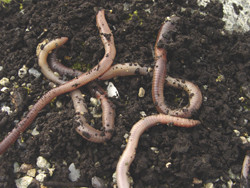Nanoparticles and earthworms
NPs are tiny pieces of materials having at least one dimension less than 100 nanometres. They have very large surface areas compared to their volumes, making them highly reactive compared to bulk counterparts of the same materials. The same qualities that make them so desirable for novel applications also raise important questions about their reactivity with people and the environment. Metal NPs are increasingly common in numerous products and are detected in the environment. The EU-funded project 'Ecotoxicity of metal nanoparticles in soils' (NANO-ECOTOXICITY) was initiated to study the specific issues of NP toxicity to organisms living in soil, a topic rarely addressed. Researchers chose two NPs with different fate kinetics, zinc oxide (ZnO) and silver (Ag). They varied both soil type to assess effects of pH on toxicity, and the soil incubation time (weeks – a year) to look at effects of aging. One soil-dwelling organism, the earthworm Eisenia andrei, served as the test case. Scientists studied uptake rate and routes and assessed internal distribution and speciation via evaluation of sectioned tissue, as well as growth and reproduction. The bioavailability and toxicity of ZnO was very much affected by soil pH as a result of related effects on particle properties and fate. Interestingly, despite lower Zn accumulation in tissues of earthworms exposed to ionic Zn compared to nano ZnO, the earthworms exposed to ionic Zn exhibited greater toxicity. In similar results, earthworms exposed to coated and uncoated Ag NPs accumulated Ag tissue concentrations above the critical Ag body burden established for Ag ions, but without suffering the same toxicity. Regarding exposure routes, NPs are most likely ingested rather than absorbed through the skin as are ionic forms of trace elements. Finally, toxicity associated with Ag NPs increased with soil incubation time over a year, suggesting that standard tests covering four weeks of exposure may not accurately reflect NP risk. NPs are increasingly used in products and thus increasingly present in the environment. NANO-ECOTOXICITY addressed an important but neglected aspect of toxicity in soils with studies of NP effects on earthworms. Results will provide important input to standardisation of tests for a comprehensive evaluation of NP risk and toxicity.
Keywords
Toxicity, nanoparticles, NPs, soil, ZnO, Ag, pH

